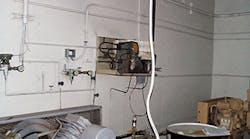Kenneth Edwards, an electrical instructor with Coastal Carolina Community College, stated that this Rigid Metal Conduit(RMC)installation is inadequate due to violations of three sections of the 2002 National Electrical Code (NEC). Section 344.30 of the NEC states that RMC shall be installed as a complete continuous system so as to maintain its mechanical continuity, in accordance with Section 300.12, when used as an equipment grounded conductor. The RMC is installed in a wet location and requires a raintight coupling. A set-screw coupling should not be used on threaded conduit ends unless the coupling is listed for the condition of use per Section 344.42(A).
The local gas company installed this gas line to supply a water heater that was located in the garage of a new house under construction. They wanted to do a neat job, so they proceeded to install the gas line inside of the wall. Their only obstacle was a 2-in. rigid nonmetallic electrical conduit that ran from the meter socket enclosure underground and up into the garage wall into the main electrical panel. They cut away a piece of the conduit to make room for the gas pipe so it would pass through to the water heater located on the other side of the panel. Keep in mind that the wiring was already in this conduit, so when it was cut, so were the cables inside. The electrical rough inspection previously passed inspection. I suppose the installer used the duct tape to pull the wires toward the front of the conduit to make a clear path for the gas pipe to pass through. It may also have been a feeble attempt to protect the already damaged wires.



